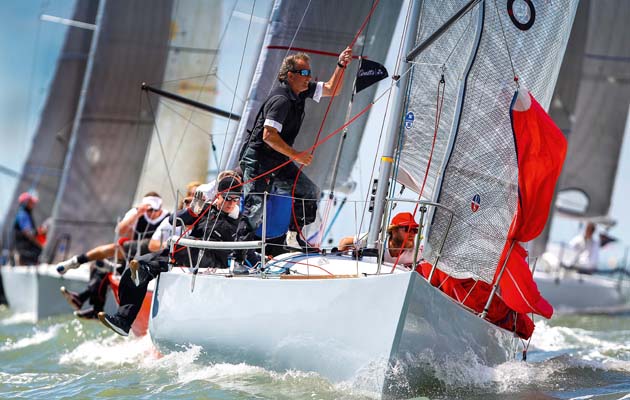They’re old, small and decidedly quirky, but quarter tonners are providing some of the hottest handicap racing in the Solent these days. Matthew Sheahan finds out why
By modern standards they are small, slow, complex to handle and trip up easily. They’re also pretty old for grand-prix machines – the newest boats in the fleet were originally launched in 1992 and the rules ban anything more recent than 1996. On deck they have barely any more freeboard than a sea boot, making for a wet ride once the breeze hits ten knots, and below decks the accommodation is barely bigger than a family cruiser’s cockpit locker.
On the plus side, moving from gunwale to gunwale simply requires rotating around one foot in the cockpit as if playing a game of Twister. And when it comes to handling, most of the time you can forget the need for a winch handle for all but the final few turns on the jib sheet after a tack.
But according to the growing band of quarter ton devotees, the biggest appeal of these quirky 25-footers is that they provide the best handicap racing in the Solent.
Depending on the fleet size you are used to, 33 boats racing at the Quarter Ton Cup may not sound a lot, but when the bulk of this fleet arrives at the top mark at the same time, the pack split between those coming in on the starboard layline and the chancers diving in on port, the first mark rounding is a nerve-racking affair. And it doesn’t stop there.
Unlike modern sportsboat fleets, which stretch out as they hoist their asymmetric spinnakers and hit double figures on the downwind leg, quarter tonners square back their poles, balance the clews of their symmetric kites and hit hull speeds as they plough their way downwind in unison. Unless there are big waves to surf, each gust simply digs a bigger hole in the surrounding water while the sheet loads increase so quickly you think the winch has seized.
Crews who have kept their boats on their feet through the gybes now reach the bottom of the downwind leg together and the boat-for-boat scrap starts once again as the pack tries to squeeze through the leeward gate.
When only fractions of a knot separate the good from the bad, there is a premium on tactics, handling, sail trim and nerve. Two or three laps of the quick-fire windward-leeward course does little to separate the bulk of the fleet and crews are kept on their toes. It is this level of racing that has fuelled the continued success of the Quarter Ton fleet, but it is not the only reason for its popularity.
What started as a nostalgic trip down memory lane as sailors compared the relics they had unearthed, discussed the amusing range of eclectic shapes and compared how little they had paid for them, has now become a competitive, thriving fleet with a life outside the Quarter Ton class.
“One of the big appeals of these boats is that they can be competitive in other events,” declares Willie McNeil, a seasoned racer and owner of the 1990 Ceccarelli-designed Illegal Immigrant. “When I started looking for a quarter tonner, I was searching for a boat to win the Round the Island Race’s Gold Roman Bowl. Having towed the boat back from Greece, where we found an illegal immigrant hiding inside at the docks in Cherbourg – hence the name – we set about rebuilding her to a modern IRC spec.
“Since then we have enjoyed plenty of competitive racing in all kinds of events in the Solent, including the Quarter Ton Cup. Not only is it great racing, it’s good value for money too, although we haven’t won the Gold Roman Bowl yet.”
Typical cost of a quarter tonner
Keel – £2,400. Standard modern replacement
Rig – £2,500. Including standing rigging
Sails – £10,000
1 x mainsail
3 x jibs – J1, J2, J3
2 x spinnakers – S1.5, S2
Boat – Impossible to nail down. Good basic boats requiring work can be £3,000-6,000, although some people have been given the boat if they were able to take it away
Overall typical budget – £30,000 if you pay to have work done; less if you get your hands dirty
This is an extract from a feature in Yachting World September 2014 issue




